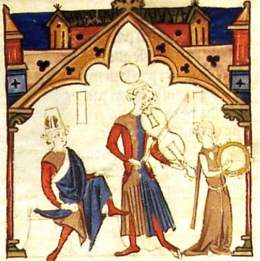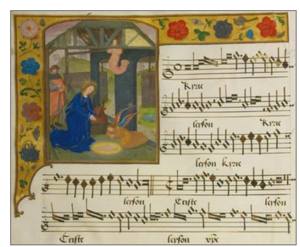Template:DRM manuscripts by repertory
Contents
Cambridge Lute Books
Website: Cambridge Lute Books
This link takes you to the second of four lute books compiled by Mathew Holmes and preserved in the Cambridge University Library. Its companions are the Cosens Lute Book and a volume of fragments of Elizabethan music for lute. Holmes was a singer at Christ Church, Oxford, and at Westminster Abbey. Cosens was a nineteenth-century owner of this collection of sixteenth-century music.
Cantigas Medievais Galego-Portuguesas
Website: Medieval Cantigas
This website provides links to collections of manuscripts containing cantigas of Gallic and Portuguese origin. Many are preserved in the Vatican Library. The contents of each source is indexed, with full texts given in many cases. A sample folio is shown for each source. Titles are listed online.
Cantus Planus
Website: Cantus Planus
In distinction to the Cantus Planus project focused on chant indexing (from the 1980s through today, under the auspices of the International Musicological Society), this website, operating under the auspices of the Austrian Academy of Sciences in Vienna, with a base at the Austrian National Library, provides a sophisticated array of digital tools and repositories for the study of medieval music. The scope of the project embraces six parts:
- Cantus Planus Austria: the primary web platform for the choral music in Austria
- Nationalbibliothek: Medieval music sources in the Austrian National Library
- Fragmente: Fragments of medieval music in the Austrian National Library
- Austriaca: Information on music manuscripts in Austrian libraries
- Text and Music Recognition: automatic recognition, transcription, and text acquisition of textual content in choral sourcces
- Bilddatenbank: an image bank of medieval music manuscripts.
Robert Klugseder directs the project.
Musica restaurata
Website: Musica restaurata
Illuminated manuscripts associated with the Low Countries in the Vatican Library can be viewed in high resolution owing to the generous support of the Alamire Foundation (Leuven, Belgium). The contents at the end of 2012 totaled 13,500 images. The image shown here comes from the workshop of Pierre Alamire (c. 1470–1536). Alamire's workshop produced many important manuscripts of the music of Johannes Ockeghem, Josquin des Prez, Adriano Willaert, and Pierre de la Rue. Alamire was a vendor of manuscripts who also used his innocent musical pursuits to conceal his operations as a spy for King Henry VIII. Manuscripts from his workshop can be found in several other European venues including Munich, Vienna, Brussels.
Polish Benedictine Music
Website: Polish Benedictine Music
This multifaceted project provides digitized images of sacred and liturgical music from Benedictine convents in the environs of Krakov. The musical sources are primarily from the 16th and 17th centuries. In addition to searchable digitized images, it also contains considerable metadata and many links to related resources as well as analytical information. An English translation is in progress.
Scottish Fiddle Tunes (Collections)
Website: Scottish Fiddle Tunes (Collections)
More than 200 books of airs, reels, hornpipes, and strathspeys are reproduced at this website at the University of Glascow. Search by title, genre etc is facilitated in an associated databse. Some sources contain period annotations. The bulk are notated on two staves in the manner of keyboard music.
Swedish Musical Heritage
Website: Swedish Musical Heritage
The Swedish Musical Heritage website represents an ongoing collaboration to make available all out-of-copyright music by Swedish composers. The alphabetical database of holdings is easily searched. It provides filters for instrumentation, composer's gender, century, and duration of each recording. Materials served include reproductions of scores, recordings of radio broadcasts, biographical information, and other related holdings of several musical institutions. Many Swedes were employed abroad, especially in Germany, and much foreign music found its way to Sweden via Germany.

